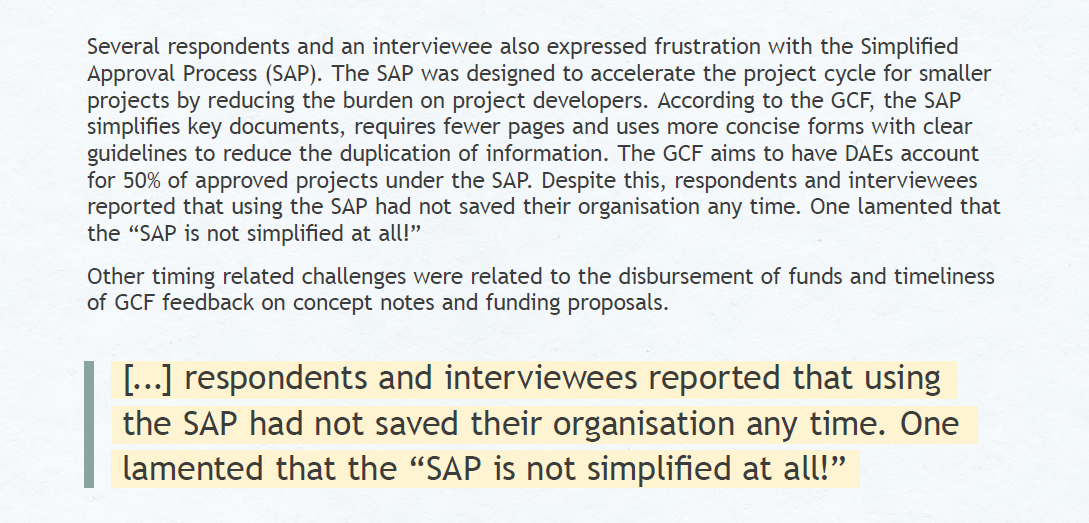Direct access fundamentals: Simplified Approval Process
15 April 2021, Category: All insights, News

This series examines each of the Green Climate Fund’s (GCF) special assistance programmes to better understand what services are available to Accredited Entities (AEs) and how they can benefit low-carbon projects. Building on our previous articles on both the Readiness Programme and the Project Preparation Facility (PPF), this article explores support provided through the Simplified Approval Process (SAP).
Accessing funding for climate projects often requires a complex multi-stage process that typically benefits from expert assistance. Many projects that have a strong theoretical approach or concept lack the detail to transition to a successful, full funding proposal. The GCF hopes to streamline these processes to promote stronger country ownership and enhance the ability of AEs to benefit from valuable climate finance. Nonetheless, the SAP in its current form is under-delivering on its grand ambitions.
What is the Simplified Approval Process? Key features and benefits
The key characteristics of the SAP lie in its name. The process, in theory, hopes to simplify the various necessary stages to reach project approval, therefore reducing the time and complexity required for projects to move from a concept to having a real-world impact. It aims to do this through:
- Making the required documentation simpler – key documents are presented in a single list
- Reducing the length of documents – funding proposals no longer run to 50 or 100 pages, with the new maximum now capped at 20 pages or 10,000 words
- Publishing new guidance that asks simpler questions and provides clear guidance to allow for more focused responses
This process supposedly aims to allow countries to access funds as quickly and efficiently as possible, apply best practices to reduce the time needed to undertake the typical project proposal and enhance the disbursement process.
- If successful, a key benefit of the SAP will be ensuring equal support is available for both the private and public sector. Private investors are often discouraged from engaging in such projects due to lengthy processes and timelines, thereby drawing out the time taken to achieve returns. Therefore, any way to shorten this is highly desirable. The SAP seeks to plug this gap. With less time and effort necessary to prepare project documents, the speed of approval increases significantly. In turn, this makes the SAP particularly attractive to private investors – a characteristic the GCF deems a unique advantage for its private sector partners.
Which projects are eligible?
Smaller projects are the main aim of the SAP, with them being assessed on three eligibility criteria:
- The project must be ready to be scaled-up and has the potential, as outlined in the concept note, to make a significant impact
- Although the overall project size can be greater than USD 10 million, that figure is the maximum funding the GCF can provide and can come from grants, loans, guarantees or equity
- Projects must have minimal to no social and environmental risks – category C – detailed safeguarding studies and/or risk assessments are not required because SAP proposals can build upon existing projects that have already identified technologies and solutions with a positive impact on climate change
Equally, there are no specific recommendations or requirements for the types of projects that can be supported. The SAP can assist projects or programmes that focus on any area, industry or sector where mitigation or building adaptive resilience is possible, including micro-scale renewable energy, forest management and small-scale rural and urban community projects.
As of today, the GCF has approved over USD 200 million in funding for 23 projects under the SAP so far, mostly in developing African and Asian nations, with many more in the pipeline. Around 40% of the funding has gone to DAEs, although their own goal is to increase this figure to around 50%.
Challenges with the SAP – Recommendations, resources and our work

Excerpt from GCF insight #17 – ‘Stakeholder views on the GCF’s direct access modality’
Despite the GCF’s lofty goals for the SAP, it has struggled to deliver the necessary simplification for a streamlined and efficient process. For example, many SAP projects, including the recently approved SAP 020 in Micronesia, still have very lengthy funding proposals.
Equally, E Co.’s recently published GCF insight #17 found that survey respondents reported frustration with the SAP, saying that it has not saved their organisation any time. One even noted that the “SAP is not simplified at all!”
This echoes our previous report, GCF insight #11, from 2019. At the time of that survey, a key theme among respondents indicated that a lack of knowledge resources, such as case studies, best practices, webinars, guidelines etc, could hinder their capacity to develop a successful SAP project.
The GCF has since published a wide variety of resources to aid the SAP, including updated guidelines, templates for concept notes, budgets and environmental and social action plans, webinars and even an e-learning course. Considering eligible projects can take many forms, the GCF developed specific technical guidelines for each area of focus, such as water security, forests and land use, cities, renewable energy, and more. Accredited entities are especially encouraged to utilise these resources to inform the project proposal process.
However, even the GCF board acknowledges that the SAP is not working as it should. During the last board meeting, members discussed the SAP at great length. Updates including allowing a rolling review of SAP projects rather than three submission windows each year, expanding eligible activities under the SAP, allowing approval between board meetings, and delegating responsibility to the Executive Director were all proposed. While there were mixed responses to these suggestions, and no decision was made, the overarching theme was that reducing the burden of complex and tedious documentation and enhancing access will be the most effective ways of improving the process. One board member lamented that “the SAP is simple by name only.”
At E Co. we have experience in working on SAP eligible projects. Our consultants led the project design and formulation of the GCF SAP Funding Proposal to scale up climate resilience of smallholder farmers and pastoralists in Kenya in targeted counties. We led a team of national and international experts to complete a full funding proposal package, including developing a feasibility study to identify resilient agricultural activities suited for each of the target counties.
More recently, our team worked to respond directly to GCF’s comments, developed annexes and refined the SAP concept note for finalisation for a project in Cambodia aiming to build climate resilience and foster sustainable development within multiple local governments.
This series is authored by Senior consultant, Marcus Arcanjo.

Join the conversation by posting a comment below. You can either use your social account, by clicking on the corresponding icons or simply fill in the form below. All comments are moderated.